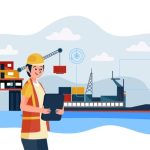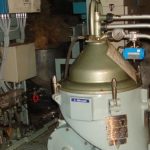A funnel which forms a part of the engine room , acts as a chimney for the exhaust of engines, boiler steam or engine room gases. It acts as a casing for the uptakes from engine room. It serves the purpose of a normal chimney, and has added modifications for meeting various pollution regulations and safety standards. It clears the exhaust gases off ships deck, and thus keeps in check fouling of ships structure or decks. The funnel houses Main engine exhaust, Generator engine exhausts, Boiler exhausts, and also funnel flaps.
The funnel size and shapes will be largely dependent on the volume of exhaust gases produced by the main propulsion engines and auxiliary engines. Funnel volume is also counted with engine room volume, and therefore should be included in all calculations involving engine room volume, for example calculating volume of CO2 needed for a fixed CO2 system.
The funnel also acts as a casing for the Main engine and auxiliary engine exhaust silencers. Catalytic convertors also finds its place inside the engine room funnel.

Funnel Flaps Working, Construction and regulations
Funnel flaps in a ship refers to the movable closures or windows present in the aft head of the funnel ( generally). Light weight gases from the engine room escapes to the outer atmosphere through the grills in the funnel or the funnel flap openings.
Hydraulic or pneumatic arrangements are provided for closing and opening the funnel flaps. By regulation, the funnel flaps should have provisions to be opened from a remote location. Usually, Fire control stations houses the remote control arrangements for funnel flap operation.
Funnel flaps are to be closed before releasing of C02 or doing a composite boiler or exhaust gas boiler cleaning by pressurizing the engine room.
Funnel flaps are to be always kept clean and lubricated well, It is a main component of the engine room, a favourite choice of psc inspectors and various other surveyors. A poorly maintained funnel flap will invite bad reports and will pose a serious threat to safety of the engine room.
It is a part of Saturday routines to check the remote and local operation of the funnel flaps , and is usually done by the fourth engineer or third assistant engineer.
Fire Cabinet or Fire Box- Contents
Fire box contains the following items
1. Fire hose
2. F-Spanner for opening the hydrant valves
3. Nozzle- Either Standard or Dual purpose; Standard nozzles will produce only jets, whereas dual purpose nozzles will produce both jet as well as Spray depending on the position of the turn key.
4. Hook spanner
5. Instructions pasted on the box


